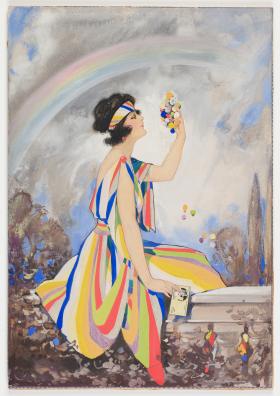Dye hard
The Tintex Girl brightened a world dulled by rationing.
Rationing was an essential part of life in Australia and around the world during the two world wars. While clothing and textiles were still being manufactured for the local market, by World War II most of these factories had moved to uniform production, restricting the availability of civilian clothing and material.
Households were forced to get creative with their clothes, reusing and repurposing what they already had, and figuring out ways to brighten up fabrics.
German firms had been the leading dye manufacturers in the early twentieth century, but the 1915 British navy blockades of German ports caused serious worldwide shortages of synthetic dyes. French, English and American fashion manufacturers responded by creating fads for black-and-white clothing and accessories, making the most of the (literal) lack of colour in the world.
Tintex, an Australian chemical business founded in the early 1900s, was savvy in its response to shortages: the company quickly expanded its tinctures and ointments to create a rainbow of colours. A breakthrough in 1920 made it the first company to successfully formulate a cold-water dye. The Sydney Morning Herald reported with relish, after visiting the Tintex stall at the Royal Hall of Industries in April 1920, that ‘the Germans with all their ingenuity and knowledge of the dye business, have never given the world a cold water dye’. With dye stocked by every pharmacist, general merchant and haberdasher, the world became a little brighter once more.
The Library recently acquired an original painting of The Tintex Girl by Edward Francis Cole, from around 1920. Holding a packet of canary-yellow dye in one hand while wearing her vivid multicoloured Art Deco-style dress, the elegant Tintex Girl is rendered in brightly opaque gouache, with coloured stripes that perfectly reflect the company’s new range of cold-water dyes.
Few details are known about the artist. Cole was a private in the British army during World War I and later became a commercial artist producing work in Australia and New Zealand. The Tintex Girl would go on to enjoy a long and colourful career. Her fashion and styling changed many times in advertising campaigns over the years to reflect the latest trends.
The brand, which appealed to a variety of customers and homemakers, expanded its kaleidoscope of colours but always promised ‘not to soil the hands or injure the most delicate fabrics’.
Tintex is still in operation today. Way back in 1924 it celebrated its cold-water dye achievement by reminding customers, with a touch of nationalism, that its product was ‘made in Australia, for Australians, by Australians. Avoid all foreign substitutes.’ The company even released a one-step song imploring people in the chorus to ‘Never say Dye, say Tintex’.
The Tintex Girl by Edward Francis Cole is on display in the Library's Amaze Gallery.
Maria Savvidis, Specialist Librarian
This story appears in Openbook winter 2022.
